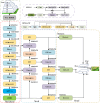Lightweight enhanced YOLOv8n underwater object detection network for low light environments
- PMID: 39537721
- PMCID: PMC11561321
- DOI: 10.1038/s41598-024-79211-7
Lightweight enhanced YOLOv8n underwater object detection network for low light environments
Abstract
In response to the challenges of target misidentification, missed detection, and other issues arising from severe light attenuation, low visibility, and complex environments in current underwater target detection, we propose a lightweight low-light underwater target detection network, named PDSC-YOLOv8n. Firstly, we enhance the input images using the improved Pro MSRCR algorithm for data augmentation. Secondly, we replace the traditional convolutions in the backbone and neck networks of YOLOv8n with Ghost and GSConv modules respectively to achieve lightweight network modeling. Additionally, we integrate the improved DCNv3 module into the C2f module of the backbone network to enhance the capability of target feature extraction. Furthermore, we introduce the GAM into the SPPF and incorporate the CBAM attention mechanism into the last layer of the backbone network to enhance the model's perceptual and generalization capabilities. Finally, we optimize the training process of the model using WIoUv3 as the loss function. The model is successfully deployed on an embedded platform, achieving real-time detection of underwater targets on the embedded platform. We first conduct experiments on the RUOD underwater dataset. Meanwhile, we also utilized the Pascal VOC2012 dataset to evaluate our approach. The mAP@0.5 and mAP@0.5:0.95 of the original YOLOv8n algorithm on RUOD dataset were 79.6% and 58.2%, respectively, and the PDSC -YOLOv8n algorithm mAP@0.5 and mAP@0.5:0.95 can reach 86.1% and 60.8%. The number of parameters of the model is reduced by about 15.5%, the detection accuracy is improved by 6.5%. The original YOLOv8n algorithm was 73% and 53.2% mAP@0.5 and mAP@0.5:0.95 on the Pascal VOC dataset, respectively. The PDSC-YOLOv8n algorithm mAP@0.5 and mAP@0.5:0.95 were 78.5% and 57%, respectively. The superior performance of PDSC-YOLOv8n indicates its effectiveness in the field of underwater target detection.
Keywords: Attention mechanisms; Deformable convolution; Low-light; Underwater target detection.
© 2024. The Author(s).
Conflict of interest statement
Figures























References
-
- Zhao, M., Zhou, H. & Li, X. YOLOv7-SN: underwater target detection algorithm based on improved YOLOv7. Symmetry16, 514 (2024).
-
- Wang, H., Zhang, P., You, M. & You, X. A method for underwater biological detection based on improved YOLOXs. Appl. Sci.14, 3196 (2024).
-
- Zhang, X., Zhu, D. & Gan, W. YOLOv7t-CEBC network for underwater litter detection. J. Mar. Sci. Eng.12, 524 (2024).
LinkOut - more resources
Full Text Sources

